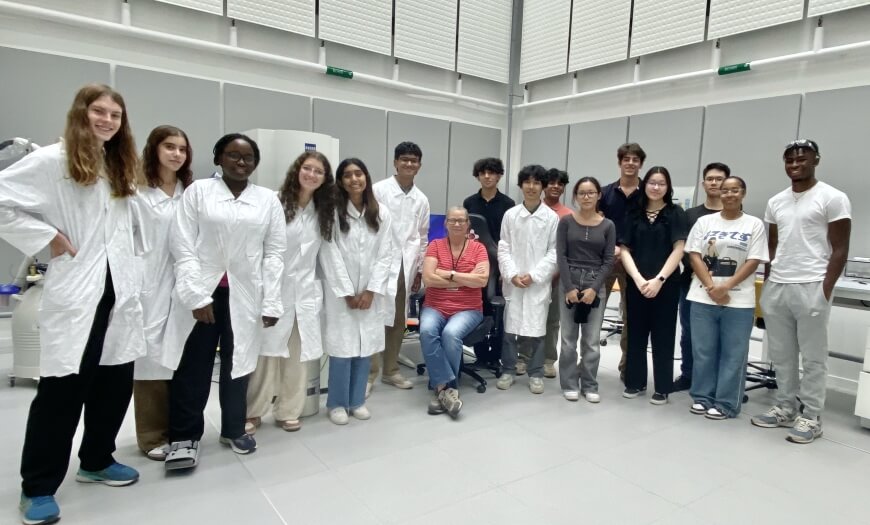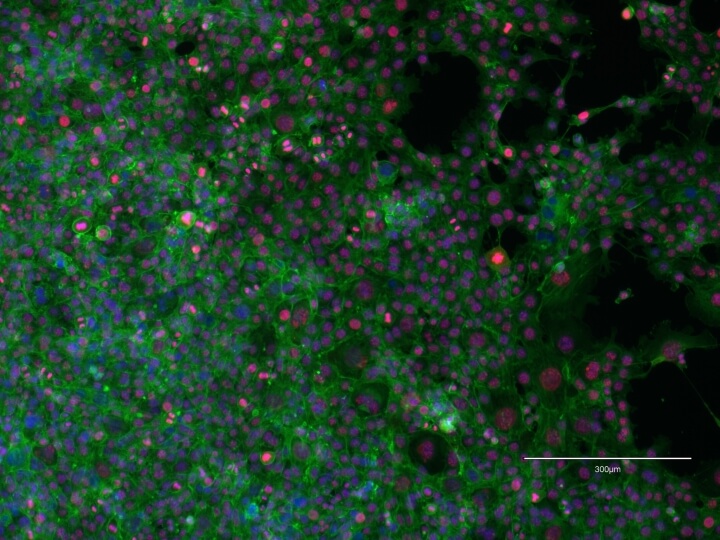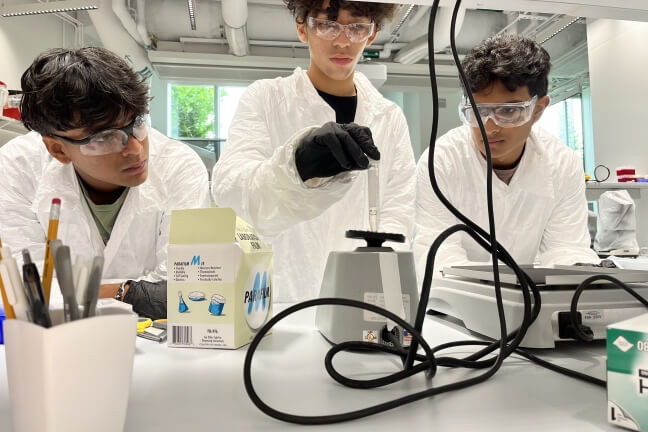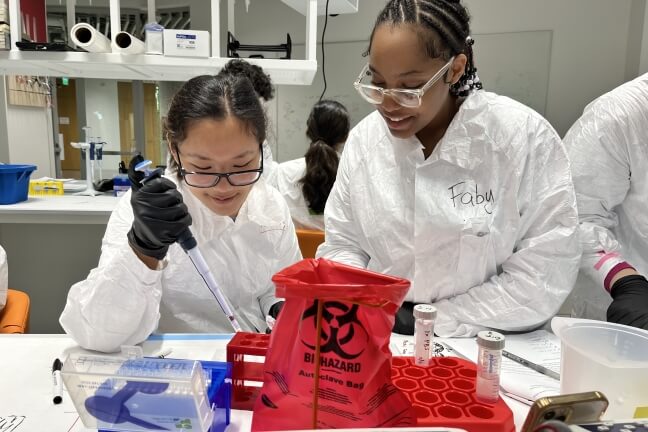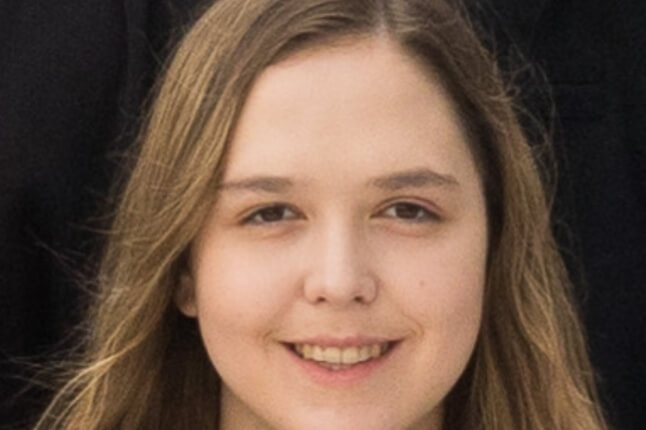News
BioSTAR participants and Nicki Watson from the Harvard Center for Nanoscale Systems following orientation on the scanning electron microscope (Melissa Hancock/SEAS)
Each summer, a cohort of Boston-area high schoolers get an opportunity to learn about bioengineering at the Harvard John A. Paulson School of Engineering and Applied Sciences (SEAS). Now in its fifth year, the BioSTAR (Bioengineering Science, Technology, and Research) program drew 15 participants from Boston-area communities. Under the faculty sponsorship of Samir Mitragotri, Hiller Professor of Bioengineering, BioSTAR is led by Active Learning Labs (ALL) members Avery Normandin and Melissa Hancock. According to Mitragotri, the mission of BioSTAR is to “give high school students an immersive experience in cutting-edge biotechnology and bioengineering research and to provide an introduction to the vision, tools, and technologies that are driving the future of therapeutics."
While the curriculum centers on cancer biology and therapeutics, it is designed to give students a comprehensive introduction to a wide range of topics in bioengineering, including biofabrication and synthetic biology. Housed in the ALL’s Bioengineering Lab, the mainstay of the program is a multi-day experiment through which participants learn to culture mammalian cancer cells in 3D environments, which more closely mimic solid-state tumors observed in vivo. They also learn to generate drug-containing nanoparticles, and use these to treat the cancer cells they have carefully cultivated. Under the guidance of guest instructors, which included SEAS graduate students and research fellows, BioSTAR students additionally performed immunofluorescence imaging, fabricated microfluidic devices, performed CRISPR-Cas9 gene editing experiments, and learned scanning electron microscopy.
“This program not only gets high schoolers excited about engineering, but also led to the development of another program offered to Harvard undergraduates for them to get excited about Bioengineering,” said Anas Chalah, Assistant Dean for Teaching and Learning.
An image of cancer cells taken by high school students in the BioSTAR program
These experiments gave students exposure to topics and techniques rarely taught in high schools, which did not go unnoticed by participants.
“I enjoyed the hands-on experience that BioSTAR gave us,” said Dominic Jorge, a rising senior at Boston Latin Academy. “This feels as if it is college-level work that we got to do, and this opportunity is like no other available. The environment was really friendly and caring. The work that we were doing felt impactful and made me interested in pursuing the complicated field of cancer.”
BioSTAR is often the very first lab experience for participants like Becky Lin, a rising senior at Newton South High School. By the end of the week, though, Lin had successfully cultured cancer cells, generated drug-containing nanoparticles, and performed fluorescence microscopy.
“I entered the program with no laboratory experience, and I had never seen a micropipette before,” she said. “I'm glad that I now have skills which I will definitely use in the future as I pursue a career in the biomedical research field. BioSTAR provided a meaningful experience that helped me build a foundation of working in a lab and taught possible applications of biomedical engineering in the real world. It was both challenging and rewarding because we combined our knowledge with practical skills, but in the end were able to produce a successful experiment.”
Jamal Warren-Gathers, a rising senior at the Brooks School in North Andover, sought an experience that would help him tap into what being an engineer really means. The hands-on nature of the program helped him to realize his vision.
“I learned that bioengineering takes focus and determination,” Warren-Gathers said. “Being in the lab and doing a lot of hands-on stuff excited me the most because it [gave me] real experience and a real understanding for this field of study.”
BioSTAR was additionally supported by a range of volunteer instructional staff, including Ari Cheriyan, Mikhal Shvartsman, Maithili Joshi, Kolade Adebowale, and Nicki Watson.
Dominic Jorge, Oishik Chakraborty, and Kabir Gokarn vortex an antibody solution for an immunostaining experiment. (Mikhal Shvartsman/SEAS)
Tenzinsherab Bachantsang from Belmont High School (left) and Fabiana Gomes from Plymouth Regional Technical High School practice micropipetting before beginning their experiments. (Melissa Hancock/SEAS)
Fabiana Gomes is a rising senior at Bristol Plymouth Regional Technical High School and an aspiring marine biologist. During BioSTAR, she participated in a range of lab techniques, including genetically engineering E. coli via CRISPR-Cas9.
“The main reason that I look forward to recommending this program to my friends and classmates is because of the friendships that you can create,” she said. “I noticed that everyone interacted with each other–no one was left out–and that is what I always look forward to when working in a laboratory.”
At the end of the program, students shared their experimental results in a presentation for SEAS staff and their family members and friends. The session was opened by Professor Kit Parker, Tarr Family Professor of Bioengineering and Applied Physics.
"The BioSTAR program has several layers of value to these young students,” Parker said. “They are getting real job skills. But they're also getting training in the scientific method, experimental design, analysis, and presentation of data and results. These are important because it's not just enough to know the bench skills but one must also be able to intellectually navigate through a scientific problem. Finally, these students get orientation to a field which might give them a long-term goal of how they want to develop themselves, how they want to make their contribution to society and how they want to express that professionally. That's the biggest win here."
Topics: Academics, Bioengineering, K-12
Cutting-edge science delivered direct to your inbox.
Join the Harvard SEAS mailing list.
